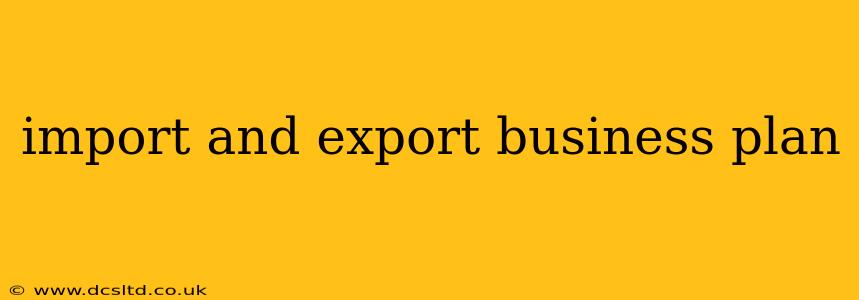Starting an import and export business can be incredibly lucrative, offering access to global markets and diverse products. However, success requires a well-structured business plan that anticipates challenges and leverages opportunities. This comprehensive guide outlines the key components of a winning import and export business plan.
Understanding the Import/Export Landscape
Before diving into specifics, it's crucial to understand the intricacies of international trade. This includes navigating customs regulations, understanding international shipping logistics, managing foreign exchange fluctuations, and identifying reliable international suppliers and buyers. Thorough research into your target markets and products is paramount.
Defining Your Niche and Target Market
What specific products will you import or export? Identifying a niche market is often key to success. Are you focusing on a specific type of consumer good, raw material, or manufactured product? Who is your ideal customer? Understanding your target market's needs, preferences, and purchasing power is essential for effective marketing and sales strategies.
What are the most profitable import/export products?
Profitability depends heavily on market demand, competition, and your ability to source and sell efficiently. High-demand items can be profitable, but competition is often fierce. Niche products may offer lower competition but require more targeted marketing. Consider products with a relatively high value-to-weight ratio to minimize shipping costs. Successful importers and exporters often identify unmet needs in specific markets.
What are the steps involved in starting an import/export business?
Starting an import/export business involves several key steps:
- Market Research: Thoroughly investigate your target market and potential product niches.
- Business Plan Development: Create a comprehensive plan outlining your goals, strategies, and financial projections.
- Legal Structure: Choose a suitable legal structure (sole proprietorship, LLC, etc.) and register your business.
- Sourcing: Identify and vet reliable international suppliers.
- Logistics: Establish relationships with freight forwarders and customs brokers.
- Financing: Secure funding to cover initial expenses and ongoing operations.
- Marketing and Sales: Develop a robust marketing and sales strategy to reach your target customers.
- Compliance: Understand and comply with all relevant import/export regulations and laws.
What are some common challenges faced by import/export businesses?
Several challenges can impact the success of import/export businesses:
- International Trade Regulations: Navigating complex customs regulations, tariffs, and quotas can be daunting.
- Logistics and Shipping: Coordinating international shipping can be complicated and expensive.
- Currency Fluctuations: Exchange rate volatility can significantly affect profitability.
- Payment Risks: Ensuring timely and secure payments from international buyers is crucial.
- Language and Cultural Barriers: Effective communication with international partners is essential.
- Competition: Competition in the global marketplace is intense.
How do I find reliable suppliers for my import/export business?
Finding reliable suppliers requires diligence and research. Utilize online directories, trade shows, and industry events to connect with potential suppliers. Thoroughly vet each supplier by verifying their credentials, checking references, and requesting samples. Consider building long-term relationships with key suppliers to ensure consistent quality and pricing.
How much money do I need to start an import/export business?
The startup costs for an import/export business vary significantly depending on your chosen products, scale of operations, and market. You'll need to account for initial inventory purchases, shipping costs, marketing expenses, legal and regulatory fees, and working capital. A detailed financial projection in your business plan will help determine your funding needs. Secure funding through personal savings, loans, or investors.
Developing Your Business Plan: Key Sections
Your business plan should include these vital components:
- Executive Summary: A concise overview of your business, its goals, and strategies.
- Company Description: Details about your business structure, mission, and vision.
- Market Analysis: Comprehensive research on your target market, competition, and industry trends.
- Products and Services: A detailed description of the products you'll import or export.
- Marketing and Sales Strategy: Your plan to reach your target customers and generate sales.
- Operations Plan: How you'll source, manage, and distribute your products.
- Management Team: Information about your team's expertise and experience.
- Financial Projections: Detailed financial statements including income statements, cash flow projections, and balance sheets.
- Funding Request (if applicable): Details of your funding needs and how you plan to use the funds.
- Appendix: Supporting documents such as market research data, supplier contracts, and resumes.
By carefully crafting a comprehensive business plan and diligently addressing the challenges of international trade, you can significantly increase your chances of success in the import and export business. Remember, ongoing adaptation and learning are crucial in this dynamic global marketplace.
